+ Open data
Open data
- Basic information
Basic information
| Entry | Database: PDB / ID: 7eda | ||||||||||||||||||||||||||||||||||||||||||
|---|---|---|---|---|---|---|---|---|---|---|---|---|---|---|---|---|---|---|---|---|---|---|---|---|---|---|---|---|---|---|---|---|---|---|---|---|---|---|---|---|---|---|---|
| Title | Structure of monomeric photosystem II | ||||||||||||||||||||||||||||||||||||||||||
 Components Components |
| ||||||||||||||||||||||||||||||||||||||||||
 Keywords Keywords | PHOTOSYNTHESIS / Photosystem / membrane protein | ||||||||||||||||||||||||||||||||||||||||||
| Function / homology |  Function and homology information Function and homology informationphotosystem II oxygen evolving complex / photosystem II assembly / oxygen evolving activity / photosystem II stabilization / photosystem II reaction center / photosystem II / oxidoreductase activity, acting on diphenols and related substances as donors, oxygen as acceptor / photosynthetic electron transport chain / photosystem II / extrinsic component of membrane ...photosystem II oxygen evolving complex / photosystem II assembly / oxygen evolving activity / photosystem II stabilization / photosystem II reaction center / photosystem II / oxidoreductase activity, acting on diphenols and related substances as donors, oxygen as acceptor / photosynthetic electron transport chain / photosystem II / extrinsic component of membrane / response to herbicide / : / plasma membrane-derived thylakoid membrane / chlorophyll binding / photosynthetic electron transport in photosystem II / phosphate ion binding / photosynthesis, light reaction / photosynthesis / respiratory electron transport chain / manganese ion binding / electron transfer activity / protein stabilization / iron ion binding / heme binding / metal ion binding Similarity search - Function | ||||||||||||||||||||||||||||||||||||||||||
| Biological species |  Thermosynechococcus vulcanus (bacteria) Thermosynechococcus vulcanus (bacteria) | ||||||||||||||||||||||||||||||||||||||||||
| Method | ELECTRON MICROSCOPY / single particle reconstruction / cryo EM / Resolution: 2.78 Å | ||||||||||||||||||||||||||||||||||||||||||
 Authors Authors | Yu, H. / Hamaguchi, T. / Nakajima, Y. / Kato, K. / kawakami, K. / Akita, F. / Yonekura, K. / Shen, J.R. | ||||||||||||||||||||||||||||||||||||||||||
| Funding support |  Japan, 6items Japan, 6items
| ||||||||||||||||||||||||||||||||||||||||||
 Citation Citation |  Journal: Biochim Biophys Acta Bioenerg / Year: 2021 Journal: Biochim Biophys Acta Bioenerg / Year: 2021Title: Cryo-EM structure of monomeric photosystem II at 2.78 Å resolution reveals factors important for the formation of dimer. Authors: Huaxin Yu / Tasuku Hamaguchi / Yoshiki Nakajima / Koji Kato / Keisuke Kawakami / Fusamichi Akita / Koji Yonekura / Jian-Ren Shen /  Abstract: Photosystem II (PSII) functions mainly as a dimer to catalyze the light energy conversion and water oxidation reactions. However, monomeric PSII also exists and functions in vivo in some cases. The ...Photosystem II (PSII) functions mainly as a dimer to catalyze the light energy conversion and water oxidation reactions. However, monomeric PSII also exists and functions in vivo in some cases. The crystal structure of monomeric PSII has been solved at 3.6 Å resolution, but it is still not clear which factors contribute to the formation of the dimer. Here, we solved the structure of PSII monomer at a resolution of 2.78 Å using cryo-electron microscopy (cryo-EM). From our cryo-EM density map, we observed apparent differences in pigments and lipids in the monomer-monomer interface between the PSII monomer and dimer. One β-carotene and two sulfoquinovosyl diacylglycerol (SQDG) molecules are found in the monomer-monomer interface of the dimer structure but not in the present monomer structure, although some SQDG and other lipid molecules are found in the analogous region of the low-resolution crystal structure of the monomer, or cryo-EM structure of an apo-PSII monomer lacking the extrinsic proteins from Synechocystis sp. PCC 6803. In the current monomer structure, a large part of the PsbO subunit was also found to be disordered. These results indicate the importance of the β-carotene, SQDG and PsbO in formation of the PSII dimer. | ||||||||||||||||||||||||||||||||||||||||||
| History |
|
- Structure visualization
Structure visualization
| Movie |
 Movie viewer Movie viewer |
|---|---|
| Structure viewer | Molecule:  Molmil Molmil Jmol/JSmol Jmol/JSmol |
- Downloads & links
Downloads & links
- Download
Download
| PDBx/mmCIF format |  7eda.cif.gz 7eda.cif.gz | 545.3 KB | Display |  PDBx/mmCIF format PDBx/mmCIF format |
|---|---|---|---|---|
| PDB format |  pdb7eda.ent.gz pdb7eda.ent.gz | 437 KB | Display |  PDB format PDB format |
| PDBx/mmJSON format |  7eda.json.gz 7eda.json.gz | Tree view |  PDBx/mmJSON format PDBx/mmJSON format | |
| Others |  Other downloads Other downloads |
-Validation report
| Summary document |  7eda_validation.pdf.gz 7eda_validation.pdf.gz | 4.2 MB | Display |  wwPDB validaton report wwPDB validaton report |
|---|---|---|---|---|
| Full document |  7eda_full_validation.pdf.gz 7eda_full_validation.pdf.gz | 4.5 MB | Display | |
| Data in XML |  7eda_validation.xml.gz 7eda_validation.xml.gz | 118.3 KB | Display | |
| Data in CIF |  7eda_validation.cif.gz 7eda_validation.cif.gz | 159.2 KB | Display | |
| Arichive directory |  https://data.pdbj.org/pub/pdb/validation_reports/ed/7eda https://data.pdbj.org/pub/pdb/validation_reports/ed/7eda ftp://data.pdbj.org/pub/pdb/validation_reports/ed/7eda ftp://data.pdbj.org/pub/pdb/validation_reports/ed/7eda | HTTPS FTP |
-Related structure data
| Related structure data |  31062MC M: map data used to model this data C: citing same article ( |
|---|---|
| Similar structure data |
- Links
Links
- Assembly
Assembly
| Deposited unit | 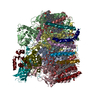
|
|---|---|
| 1 |
|
- Components
Components
-Photosystem II ... , 17 types, 17 molecules ABCDHIJKLMOTUYXZR
| #1: Protein | Mass: 37029.234 Da / Num. of mol.: 1 / Source method: isolated from a natural source / Source: (natural)  Thermosynechococcus vulcanus (bacteria) / References: UniProt: P51765, photosystem II Thermosynechococcus vulcanus (bacteria) / References: UniProt: P51765, photosystem II |
|---|---|
| #2: Protein | Mass: 55939.562 Da / Num. of mol.: 1 / Source method: isolated from a natural source / Source: (natural)  Thermosynechococcus vulcanus (bacteria) / References: UniProt: D0VWR1 Thermosynechococcus vulcanus (bacteria) / References: UniProt: D0VWR1 |
| #3: Protein | Mass: 49207.250 Da / Num. of mol.: 1 / Source method: isolated from a natural source / Source: (natural)  Thermosynechococcus vulcanus (bacteria) / References: UniProt: D0VWR7 Thermosynechococcus vulcanus (bacteria) / References: UniProt: D0VWR7 |
| #4: Protein | Mass: 38290.828 Da / Num. of mol.: 1 / Source method: isolated from a natural source / Source: (natural)  Thermosynechococcus vulcanus (bacteria) / References: UniProt: D0VWR8, photosystem II Thermosynechococcus vulcanus (bacteria) / References: UniProt: D0VWR8, photosystem II |
| #7: Protein | Mass: 6986.271 Da / Num. of mol.: 1 / Source method: isolated from a natural source / Source: (natural)  Thermosynechococcus vulcanus (bacteria) / References: UniProt: P19052 Thermosynechococcus vulcanus (bacteria) / References: UniProt: P19052 |
| #8: Protein/peptide | Mass: 4438.255 Da / Num. of mol.: 1 / Source method: isolated from a natural source / Source: (natural)  Thermosynechococcus vulcanus (bacteria) / References: UniProt: P12240 Thermosynechococcus vulcanus (bacteria) / References: UniProt: P12240 |
| #9: Protein/peptide | Mass: 4105.908 Da / Num. of mol.: 1 / Source method: isolated from a natural source / Source: (natural)  Thermosynechococcus vulcanus (bacteria) / References: UniProt: Q7DGD4 Thermosynechococcus vulcanus (bacteria) / References: UniProt: Q7DGD4 |
| #10: Protein/peptide | Mass: 4101.911 Da / Num. of mol.: 1 / Source method: isolated from a natural source / Source: (natural)  Thermosynechococcus vulcanus (bacteria) / References: UniProt: P19054 Thermosynechococcus vulcanus (bacteria) / References: UniProt: P19054 |
| #11: Protein/peptide | Mass: 4299.044 Da / Num. of mol.: 1 / Source method: isolated from a natural source / Source: (natural)  Thermosynechococcus vulcanus (bacteria) / References: UniProt: P12241 Thermosynechococcus vulcanus (bacteria) / References: UniProt: P12241 |
| #12: Protein/peptide | Mass: 3289.899 Da / Num. of mol.: 1 / Source method: isolated from a natural source / Source: (natural)  Thermosynechococcus vulcanus (bacteria) / References: UniProt: P12312 Thermosynechococcus vulcanus (bacteria) / References: UniProt: P12312 |
| #13: Protein | Mass: 26651.707 Da / Num. of mol.: 1 / Source method: isolated from a natural source / Source: (natural)  Thermosynechococcus vulcanus (bacteria) / References: UniProt: D0VWR2 Thermosynechococcus vulcanus (bacteria) / References: UniProt: D0VWR2 |
| #14: Protein/peptide | Mass: 3648.379 Da / Num. of mol.: 1 / Source method: isolated from a natural source / Source: (natural)  Thermosynechococcus vulcanus (bacteria) / References: UniProt: P12313 Thermosynechococcus vulcanus (bacteria) / References: UniProt: P12313 |
| #15: Protein | Mass: 11655.986 Da / Num. of mol.: 1 / Source method: isolated from a natural source / Source: (natural)  Thermosynechococcus vulcanus (bacteria) / References: UniProt: P56152 Thermosynechococcus vulcanus (bacteria) / References: UniProt: P56152 |
| #17: Protein/peptide | Mass: 3228.035 Da / Num. of mol.: 1 / Source method: isolated from a natural source / Source: (natural)  Thermosynechococcus vulcanus (bacteria) / References: UniProt: D0VWR3 Thermosynechococcus vulcanus (bacteria) / References: UniProt: D0VWR3 |
| #18: Protein/peptide | Mass: 4191.030 Da / Num. of mol.: 1 / Source method: isolated from a natural source / Source: (natural)  Thermosynechococcus vulcanus (bacteria) / References: UniProt: D0VWR4 Thermosynechococcus vulcanus (bacteria) / References: UniProt: D0VWR4 |
| #19: Protein | Mass: 6766.187 Da / Num. of mol.: 1 / Source method: isolated from a natural source / Source: (natural)  Thermosynechococcus vulcanus (bacteria) / References: UniProt: D0VWR5 Thermosynechococcus vulcanus (bacteria) / References: UniProt: D0VWR5 |
| #20: Protein/peptide | Mass: 3859.732 Da / Num. of mol.: 1 / Source method: isolated from a natural source / Source: (natural)  Thermosynechococcus vulcanus (bacteria) / References: UniProt: P0DM37 Thermosynechococcus vulcanus (bacteria) / References: UniProt: P0DM37 |
-Cytochrome b559 subunit ... , 2 types, 2 molecules EF
| #5: Protein | Mass: 9580.840 Da / Num. of mol.: 1 / Source method: isolated from a natural source / Source: (natural)  Thermosynechococcus vulcanus (bacteria) / References: UniProt: P12238 Thermosynechococcus vulcanus (bacteria) / References: UniProt: P12238 |
|---|---|
| #6: Protein/peptide | Mass: 5067.900 Da / Num. of mol.: 1 / Source method: isolated from a natural source / Source: (natural)  Thermosynechococcus vulcanus (bacteria) / References: UniProt: P12239 Thermosynechococcus vulcanus (bacteria) / References: UniProt: P12239 |
-Protein / Sugars , 2 types, 5 molecules V

| #16: Protein | Mass: 18046.943 Da / Num. of mol.: 1 / Source method: isolated from a natural source / Source: (natural)  Thermosynechococcus vulcanus (bacteria) / References: UniProt: P0A387 Thermosynechococcus vulcanus (bacteria) / References: UniProt: P0A387 |
|---|---|
| #30: Sugar | ChemComp-DGD / |
-Non-polymers , 15 types, 79 molecules 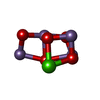






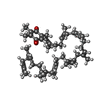
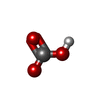



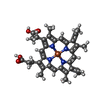














| #21: Chemical | ChemComp-OEX / | ||||||||||||||||||||||||
|---|---|---|---|---|---|---|---|---|---|---|---|---|---|---|---|---|---|---|---|---|---|---|---|---|---|
| #22: Chemical | ChemComp-FE2 / | ||||||||||||||||||||||||
| #23: Chemical | ChemComp-CLA / #24: Chemical | #25: Chemical | ChemComp-BCR / #26: Chemical | #27: Chemical | #28: Chemical | #29: Chemical | ChemComp-UNL / | Mass: 949.299 Da / Num. of mol.: 1 / Source method: obtained synthetically / Feature type: SUBJECT OF INVESTIGATION #31: Chemical | ChemComp-BCT / | #32: Chemical | ChemComp-LHG / #33: Chemical | ChemComp-HEM / | #34: Chemical | ChemComp-RRX / ( | #35: Chemical | ChemComp-HEC / | #36: Water | ChemComp-HOH / | |
-Details
| Has ligand of interest | Y |
|---|---|
| Has protein modification | Y |
-Experimental details
-Experiment
| Experiment | Method: ELECTRON MICROSCOPY |
|---|---|
| EM experiment | Aggregation state: PARTICLE / 3D reconstruction method: single particle reconstruction |
- Sample preparation
Sample preparation
| Component | Name: Photosystem II / Type: COMPLEX / Entity ID: #1-#6, #8-#20 / Source: NATURAL |
|---|---|
| Source (natural) | Organism:  Thermosynechococcus vulcanus (bacteria) Thermosynechococcus vulcanus (bacteria) |
| Buffer solution | pH: 6 |
| Specimen | Embedding applied: NO / Shadowing applied: NO / Staining applied: NO / Vitrification applied: YES |
| Vitrification | Cryogen name: ETHANE |
- Electron microscopy imaging
Electron microscopy imaging
| Microscopy | Model: JEOL CRYO ARM 300 |
|---|---|
| Electron gun | Electron source:  FIELD EMISSION GUN / Accelerating voltage: 300 kV / Illumination mode: FLOOD BEAM FIELD EMISSION GUN / Accelerating voltage: 300 kV / Illumination mode: FLOOD BEAM |
| Electron lens | Mode: BRIGHT FIELD |
| Image recording | Electron dose: 70 e/Å2 / Film or detector model: GATAN K3 (6k x 4k) |
- Processing
Processing
| Software | Name: PHENIX / Version: 1.14_3260: / Classification: refinement | ||||||||||||||||||||||||
|---|---|---|---|---|---|---|---|---|---|---|---|---|---|---|---|---|---|---|---|---|---|---|---|---|---|
| EM software | Name: PHENIX / Category: model refinement | ||||||||||||||||||||||||
| CTF correction | Type: NONE | ||||||||||||||||||||||||
| 3D reconstruction | Resolution: 2.78 Å / Resolution method: FSC 0.143 CUT-OFF / Num. of particles: 173875 / Symmetry type: POINT | ||||||||||||||||||||||||
| Refine LS restraints |
|
 Movie
Movie Controller
Controller



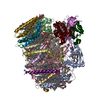
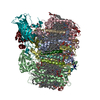
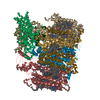
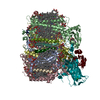
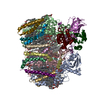


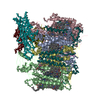
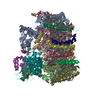
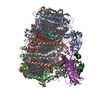
 PDBj
PDBj




























